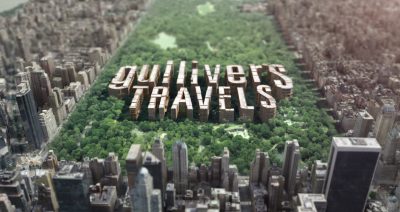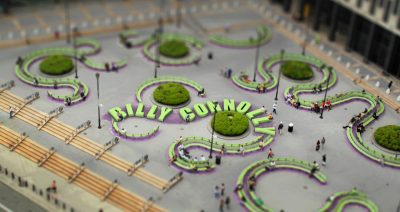
The main titles to Gulliver’s Travels feature the names of the actors and filmmakers incorporated into tilt-shift scenes of New York City, introducing the film’s scale motif and setting the scene for Gulliver to build his self-confidence and feel ‘big’ again. “Tilt-shift makes things look miniature,” says Lee Nelson, visual effects supervisor for the company responsible for the titles, Rok!t Studio. “The way it does that is by adding depth of field. You get a lot of foreground blur and a lot of background blur and you’re just focused on a narrow piece that’s in focus.”
Additional video just for you as an fxinsider member
This clip is the uncut opening titles of the film Gulliver’s Travels , showing the results of the timelapse Canon 1D shoot.
[mepr-show if=”rule: 246100″]
[/mepr-show]
“Also,” says Nelson, “the director wanted the audience to watch the movie and not until half way through the titles realise they were watching real shots of New York City. He wanted them to think we’d spent the time making a miniature version, and he wanted to pick places so that when we did the effect it would really showcase it – like little boats that move and little persons and benches.”
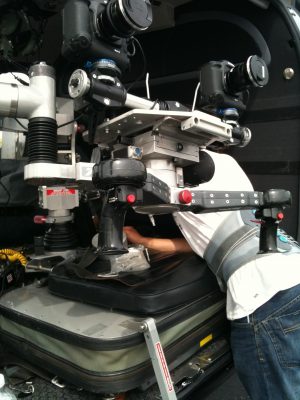 Rok!t experimented with a methodology of shooting footage on DSLRs in a time-lapse manner with and without tilt-shift lenses, ultimately settling on shooting RAW with the Canon EOS 1D Mark IV, but creating the tilt-shift look in post for more control. Although this meant a relatively small footprint for filming real New York locations, the decision was also made to shoot in stereo and not dimensionalise in post, necessitating the use of a dual camera set-up. “When we were doing our R&D we were trying to figure out if it was even possible to have two cameras that are digital SLRs shooting at the exact same time,” says Nelson. “If one shutter is off by a quarter of millisecond, by the time you’re done with your sequence, each camera won’t be shooting the same thing.”
Rok!t experimented with a methodology of shooting footage on DSLRs in a time-lapse manner with and without tilt-shift lenses, ultimately settling on shooting RAW with the Canon EOS 1D Mark IV, but creating the tilt-shift look in post for more control. Although this meant a relatively small footprint for filming real New York locations, the decision was also made to shoot in stereo and not dimensionalise in post, necessitating the use of a dual camera set-up. “When we were doing our R&D we were trying to figure out if it was even possible to have two cameras that are digital SLRs shooting at the exact same time,” says Nelson. “If one shutter is off by a quarter of millisecond, by the time you’re done with your sequence, each camera won’t be shooting the same thing.”
Rok!t also tested the high speed shutter burst mode on the Mark IV that shoots eight frames a second. “We had two cameras sync’d up on high burst mode and we’d let it fire,” says Nelson. “But within three seconds it was out of sync.” The solution came from a small circuit board controller purchased at RadioShack that was hard-wired into the lens to bypass the automatic shutter. The result was that the two cameras could take high speed stills at the same time.
A parallel camera rig was then built to fit the two cameras and separate them from between three inches to three feet. “The reason why we had to go three feet,” says Nelson, “was that a lot of our shots would have 200mm lenses on them and in order to get any stereo out of it, we’d have to separate the cameras further apart.”
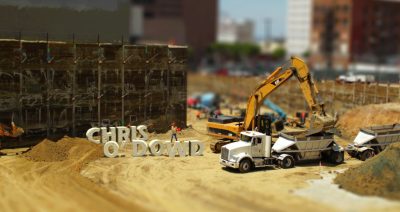 Concepts for the titles were boarded and locations previewed via Google Earth and Maps. A location scout in New York also made sure that the background plates were achievable. To shoot the plates, Nelson travelled to New York with a small team. “We would go to places and tell them we were shooting for a movie, but when they saw our equipment and noticed we were basically a photography crew instead of a big film crew, it was much easier to get around,” says Nelson. “It was very exhilarating to be able to just get in and out at the speed we could.”
Concepts for the titles were boarded and locations previewed via Google Earth and Maps. A location scout in New York also made sure that the background plates were achievable. To shoot the plates, Nelson travelled to New York with a small team. “We would go to places and tell them we were shooting for a movie, but when they saw our equipment and noticed we were basically a photography crew instead of a big film crew, it was much easier to get around,” says Nelson. “It was very exhilarating to be able to just get in and out at the speed we could.”
Almost all of the plates were lock-offs shot with the DSLRs, although three shots were captured with the Genesis camera in order to gather moving images towards the end of the title sequence and match the rest of the film. The main title – ‘Gulliver’s Travels’ – rested in Central Park, with the background a digital stitching of helicopter plates of the location. “We got a helicopter and flew over Central Park,” says Nelson. “I was strapped in there. We had to take our rig and put it on a Tyler mount – a camera mount that is the skeletons of a 50 calibre machine gun, but instead of the gun you put your camera on there. Unfortunately, President Obama was in New York City at the time we were flying and the rule is you cannot fly over the President’s convoy and he was right on Fifth Street. So we ended up shooting every perspective of Central Park and we digitally recreated the entire shot in the computer with projection methods.”
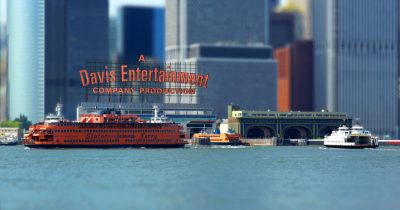 Once all the plates had been shot, co-ordinators at Rok!t organised the data – about 50 terabytes since some of the plates were 8K – and made selects before the shots were created as an animatic and cut to length. The team would then pick the relevant depth cues. “Let’s say it was the shot overlooking the sunrise,” says Nelson. “There’s a boat in the foreground and you have the water, then you have the city skyline and then things in the back. If it wasn’t too intricate or too complicated, I would build everything in the scene digitally with just primitive shapes. Then I would render out a depth map. I could re-project our imagery back on to the geometry in Maya and could push the stereo even more or less. We built a stereoscopic camera rig in Maya – Maya comes with a default one – but we had to match ours to our DLSR cameras.”
Once all the plates had been shot, co-ordinators at Rok!t organised the data – about 50 terabytes since some of the plates were 8K – and made selects before the shots were created as an animatic and cut to length. The team would then pick the relevant depth cues. “Let’s say it was the shot overlooking the sunrise,” says Nelson. “There’s a boat in the foreground and you have the water, then you have the city skyline and then things in the back. If it wasn’t too intricate or too complicated, I would build everything in the scene digitally with just primitive shapes. Then I would render out a depth map. I could re-project our imagery back on to the geometry in Maya and could push the stereo even more or less. We built a stereoscopic camera rig in Maya – Maya comes with a default one – but we had to match ours to our DLSR cameras.”
“The depth map also allowed us to blur or rack focus,” adds Nelson. “We were able to basically generate a luminance element that said: ‘if this is darker, blur this more, or if this is whiter, don’t blur it’. So as things receded into the background, they got darker. That was a matte that was used to control how much the tilt-shift effect would be.”
Incorporating the actual type into the scenes turned out to be the trickiest part of the process. It was done either as 3D lettering created in Maya or via matte paintings re-projected in Nuke. “It’s not that hard if it’s a mono job,” explains Nelson, “but for stereo if you’re replacing a bench with the word Bill Connolly and there’s somebody sitting down on the bench and you want that person to sit on top of the letter ‘Y’, his butt has to be in the exact stereo space as the type. If we were one pixel off, that would be like three feet off in world space.”
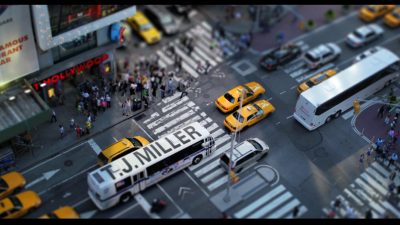
For shots of traffic or people interacting with the titles, Rok!t used difference mattes and also employed roto and matchmove artists to clean up the rest of the plates, often twice for stereo, although by the end they were able to use some specific stereo roto tools like Ocula for Nuke.
Rok!t spent a total of nine months on the main titles, initially with just four artists, with further work extended for an animated newspaper end title sequence. “The main titles work reminded me of going back to film a bit,” says Nelson, “since we were shooting stereo and didn’t always know what we were going to get. We didn’t have a monitor to review our work while it was being shot. We had to use really old formulas for working out things like how far the cameras had to be apart if the action was 300 yards away and we’re using a 200mm lens. But I really loved it.”

